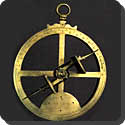 The early seamen sailed by the sun and stars, rarely venturing out of sight of the land. Then the Chinese discovered the lode-stone or guiding stone, and the fact that it always pointed to the magnetic north. It was first used in Europe in the twelfth century, and the idea of attaching it to a compass card is credited to Flavia Gioia of Amalfi in 1302. Latitude was worked out by observing the sun with a ‘cross-staff’, a wooden T-square with a sliding cross-piece which was moved until one end was in line with the sun and the other with the horizon. The ‘back-staff’ and astrolabe were also used to estimate latitude. Accurate longitude was impossible to determine until a Yorkshireman, John Harrison, invented a reliable time-keeper in the eighteenth century.
The early seamen sailed by the sun and stars, rarely venturing out of sight of the land. Then the Chinese discovered the lode-stone or guiding stone, and the fact that it always pointed to the magnetic north. It was first used in Europe in the twelfth century, and the idea of attaching it to a compass card is credited to Flavia Gioia of Amalfi in 1302. Latitude was worked out by observing the sun with a ‘cross-staff’, a wooden T-square with a sliding cross-piece which was moved until one end was in line with the sun and the other with the horizon. The ‘back-staff’ and astrolabe were also used to estimate latitude. Accurate longitude was impossible to determine until a Yorkshireman, John Harrison, invented a reliable time-keeper in the eighteenth century.
Check Also
World Lupus Day: Date, History, Significance, Facts about autoimmune disease
World Lupus Day is dedicated to people worldwide who suffer from this debilitating autoimmune disease …
 Kids Portal For Parents India Kids Network
Kids Portal For Parents India Kids Network






